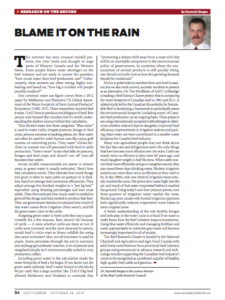Blame it on the Rain
This article written by Dr. Reynold Bergen, BCRC Science Director, originally appeared in the October 26, 2015 issue of Canadian Cattlemen magazine and is reprinted on the BCRC Blog with permission of the publisher.
This summer has seen unusual rainfall patterns, low river levels and drought in large parts of Western Canada and the Western States. Some people blame water shortages on the beef industry and are ready to answer the question “how much water does beef production use?” Unfortunately, these answers are often wrong, highly misleading and based on “how big a number will people possibly swallow?”
One common water use figure comes from a 2012 paper by Mekkonen and Hoekstra (“A Global Assessment of the Water Footprint of Farm Animal Products”, Ecosystems 15:401-415). These researchers reported that it takes 15,415 liters to produce one kilogram of beef. Few people look beyond that number, but it’s worth understanding the shallow science behind that calculation.
They divided water into three categories. “Blue water” is used to water cattle, irrigate pastures, forage or feed crops, process carcasses at packing plants, etc. Blue water can often be used for other human uses like crops, golf courses, or swimming pools. “Grey water” dilutes fertilizer or manure runoff associated with feed or cattle production. “Green water” is rain that falls on pastures, forages and feed crops and doesn’t run off (runoff becomes blue water).
Actual rainfall measurements are sparse in remote areas, so green water is usually estimated. Here’s how that calculation works. They estimate how much forage and grain it takes to raise cattle on pasture or in feedlots, based on average feed conversion efficiencies. They adjust average live finished weights to a “per kg beef” equivalent using dressing percentages and lean meat yields. Then they estimate how much water is needed to grow all the forage and feed needed to produce that beef. They use government statistics to estimate how much of that water comes from irrigation (blue water), and bill the green water (rain) to the cattle.
Assigning green water to beef cattle this way is questionable for a few reasons. Rain doesn’t fall because of cattle – it rains whether cattle are there or not. If cattle were removed and the land returned to nature, would beef’s critics start to blame wildlife for using that same rainwater? Also, not all rainwater is used by plants. Some percolates through the soil to maintain and recharge groundwater reserves. A lot of pasture and rangeland simply isn’t environmentally suited to crop production, either.
Including green water in the calculation made the water footprint of beef a lot larger. If you factor out the green water estimate, beef’s water footprint shrinks by 94%! But a large number like 15,415 l/kg beef allowed Mekkonen and Hoekstra to conclude that “promoting a dietary shift away from a meat-rich diet will be an inevitable component in the environmental policy of governments. In countries where the consumption of animal products is still quickly rising, one should critically look at how this growing demand should be moderated”.
It’s fun to poke holes in numbers from anti-beef crusaders, but we also need current, accurate numbers to present as an alternative. Dr. Tim McAllister of AAFC Lethbridge is leading a Beef Science Cluster project that is comparing the water footprint of Canadian beef in 1981 and 2011. A related study led by the Canadian Roundtable for Sustainable Beef is developing a framework to periodically assess the environmental footprint (including water) of Canada’s beef production on an ongoing basis. These projects are using internationally-accepted methodologies to determine whether reduced days to slaughter, improved feed efficiency, improvements in irrigation systems and packing plant water use have contributed to a smaller water footprint for Canada’s beef industry.
Many non-agriculture people may not think about the fact that cars and refrigerators aren’t the only things that have become more efficient over the years. Cattle are nearly twice as efficient as they were 60 years ago, and reach slaughter weight in half the time. When cattle convert feed more efficiently and go to slaughter sooner, they also spend fewer days drinking water. Modern irrigation systems are more than twice as efficient as they used to be. In the 1960’s, only one third of irrigation water actually reached the roots. Old pivots shot water high into the air, and much of that water evaporated before it reached the ground. Using today’s new low pressure pivots, over three quarters of irrigation water reaches the roots. Replacing open canals with buried irrigation pipelines have significantly reduced evaporative water losses in some irrigated areas.
A better understanding of the role healthy forages and soils play in the water cycle is critical if we want to really know how the beef industry impacts ecosystems. Using blue water efficiently and managing fertilizer and waste appropriately to minimize gray water will become increasingly important for all of society.
Click here to subscribe to the BCRC Blog and receive email notifications when new content is posted.
The sharing or reprinting of BCRC Blog articles is typically welcome and encouraged, however this article requires permission of the original publisher.
We welcome your questions, comments and suggestions. Contact us directly or generate public discussion by posting your thoughts below.
